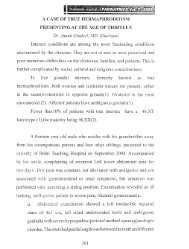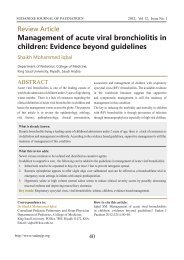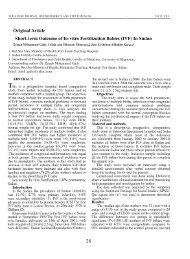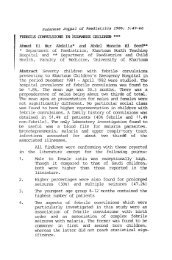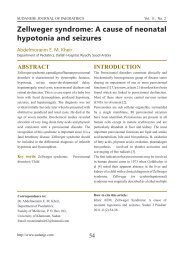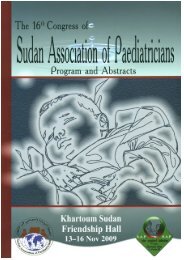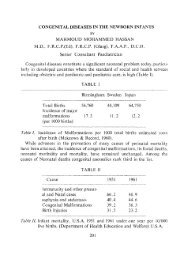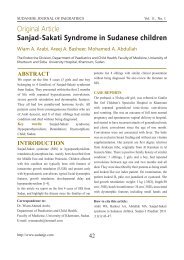Cerebral Malaria in Children: A Review of ... - Sudanjp.org
Cerebral Malaria in Children: A Review of ... - Sudanjp.org
Cerebral Malaria in Children: A Review of ... - Sudanjp.org
Create successful ePaper yourself
Turn your PDF publications into a flip-book with our unique Google optimized e-Paper software.
SUDANESE JOURNAL OF PAEDIATRICS AND CHILD HEALTH VallO: 2010transfusions rema<strong>in</strong>s highly controversial, as they areboth expensive and potentially dangerous <strong>in</strong> manymalaria-endemic areas.Pentoxifyll<strong>in</strong>e helps microcirculatory flowby reduc<strong>in</strong>g the red cell deformability and bloodviscosity, decreases systemic vascular resistanceand impairs platelet aggregation thus improv<strong>in</strong>gmicrocirculatory flow.Desferrioxam<strong>in</strong>e this is an iron-chelat<strong>in</strong>g adjuvantagent with antimalarial properties is suggested as itreduces the formation <strong>of</strong> reactive oxygen species byreduc<strong>in</strong>g amount <strong>of</strong> free iron.52The follow<strong>in</strong>g drugs should not be adm<strong>in</strong>istered:Anti-Inflammatories such as corticosteroids.However, there have been few controlled studiesdemonstrat<strong>in</strong>g benefit. other anti<strong>in</strong>flammatory drugs;low molecular weight dextran; adrenal<strong>in</strong>e; hepar<strong>in</strong>;hyperbaric oxygen; cyclospor<strong>in</strong> should be avoided.Dehydration and hypovolemia <strong>in</strong> children withcerebral malaria should be corrected with <strong>in</strong>travenousfluids or colloid. Lactic acidosis can be correctedby aggressive management <strong>of</strong> malarial <strong>in</strong>fection,volume replacement if the patient is dehydrated andtransfusion <strong>of</strong> blood as appropriate.The mortality <strong>of</strong> untreated severe malaria can be100%, but with antimalarial treatment, the overallmortality falls to 15-20%. As death from severemalaria can occur with<strong>in</strong> hours <strong>of</strong> admission tohospital or cl<strong>in</strong>ic, it is essential that therapeuticconcentrations <strong>of</strong> antimalarial are achieved as soonas possible with <strong>in</strong>travenous antimalarials. Further,gastro<strong>in</strong>test<strong>in</strong>al <strong>in</strong>tolerance and erratic <strong>in</strong>test<strong>in</strong>alabsorption make the oral route <strong>of</strong> adm<strong>in</strong>istrationunreliable <strong>in</strong> these patients. As resistance toantimalarial drugs can complicate matters further,proper choice <strong>of</strong> antimalarials to start the treatmentis <strong>of</strong> utmost importance; chang<strong>in</strong>g the drugs oradd<strong>in</strong>g <strong>of</strong> drugs half-way through the treatment onlycomplicates the issue and adds to the adverse effects<strong>of</strong> treatment. <strong>Children</strong> with cerebral malaria shouldbe treated with <strong>in</strong>travenous or <strong>in</strong>tramuscular Qu<strong>in</strong><strong>in</strong>e,or <strong>in</strong>tramuscular Artemis<strong>in</strong><strong>in</strong> derivatives.53Consequences and Prognosis <strong>of</strong> <strong>Cerebral</strong> <strong>Malaria</strong><strong>Cerebral</strong> malaria carries a mortality <strong>of</strong> around 20%<strong>in</strong> adults and 15% <strong>in</strong> children. Factors associated witha fatal outcome <strong>in</strong>cluded deep breath<strong>in</strong>g or acidosis(base excess below -8), hypotension (systolic bloodpressure < 80mmHg), raised plasma creatn<strong>in</strong>e (>80]tmolll), low oxygen saturation «90%), dehydrationand hypoglycaemia «2.5 mmolll). Approximately7% <strong>of</strong> children who survive CM are left withpermanent neurological problems. These <strong>in</strong>cludeweakness, spasticity, bl<strong>in</strong>dness, speech problemsand epilepsy. Recent evidence suggests that somechildren who appear to have made a completeneurological recovery from cerebral malaria maydevelop significant cognitive problems (attentiondeficits, difficulty with plann<strong>in</strong>g and <strong>in</strong>itiat<strong>in</strong>g tasks,speech and language problems), which can adverselyaffect school performance and persist for years afterthe attack.54 The limited availability <strong>of</strong> specializedcare for such children <strong>in</strong>dicates that opportunitiesfor subsequent learn<strong>in</strong>g and for atta<strong>in</strong>ment <strong>of</strong><strong>in</strong>dependence, are compromised even further.References1- Newton. CR.1nteraction between Plasmodium falciprum andhuman immunodeficiency virus type 1on the central nervoussystem <strong>of</strong> African children.».I Neurovirol 2005; 11 suppl 3:4551-.2--Luhan, M. <strong>Malaria</strong>. WHO Press Office fact sheet 94. P. 1-3.World Health Organization, Geneva, Switzerland. 1996.3- WHO. Current epidemiological situation.TDR Roll Back<strong>Malaria</strong>. Report: 2002.4- Ch<strong>in</strong>, 1. (Ed.) (2000). Control <strong>of</strong> communicable diseasesmanual (17th ed.). Wash<strong>in</strong>gton, DC: American Public HealthAssociation.21



